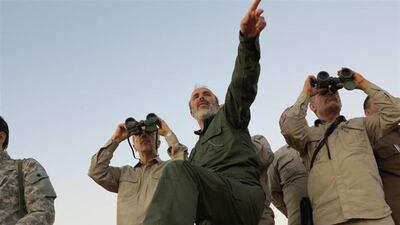As the world watches helplessly while Syria’s brutal civil war suffers yet another devastating humanitarian crisis, the one country that has successfully exploited the horrors of the past seven years for its own advancement is Iran.
Ever since the first anti-government protests took place on the streets of Damascus in March 2011, Iran has been determined to do everything in its power to ensure the survival of the Assad regime, its key regional ally.
In the early days of the conflict, Iran’s involvement was limited to sending a few hundred military advisors to assist the hard-pressed forces of Syrian dictator Bashar Al Assad as they struggled to contend with a nationwide rebellion.
Then, in the summer of 2014, when it looked as though the Assad forces were about to defeated by the rebels, it was Iran’s successful effort to persuade Moscow, which also has long-standing strategic ties with Damascus, to intervene militarily in a way that changed the course of the conflict in the Syrian regime’s favour.
The result is that, seven years on, Iran’s position in the country has changed radically, to the extent that it has, in effect, created a state within a state, with the Revolutionary Guards Corps having established a nationwide infrastructure of military bases, including its own airstrips and training bases, as well as command and control centres for sophisticated weaponry such as drones.
Iran’s creation of its own independent military network in Syria is, in many respects, a rerun of its takeover of neighbouring southern Lebanon in the 1980s, where it successfully exploited its links with the local Shia community to establish the pro-Iran Hezbollah militia.
These days, apart from comprising the main military force in southern Lebanon, Hezbollah likes to think of itself as a political movement, one that can challenge successfully to control the whole of the country.
Whether Iran entertains similar political ambitions for Syria remains to be seen. For the moment, Tehran appears happy to maintain its support for Mr Al Assad – so long, that is, as the Syrian leader remains amenable to Iran’s requests to consolidate its hold over large tracts of Syrian soil.
The evolution of Iran from being an ally to a significant stakeholder in Syria is certainly having a dramatic impact on the course of the conflict as it enters yet another phase of horrific bloodshed and slaughter.
Iranian-trained militias have been at the forefront of the recent military offensive in the northwestern city of Afrin, where forces loyal to the Assad regime have joined forces with local Kurdish groups to fight off an incursion by Turkish troops.
Iranian troops have also been accused by the UN and other bodies of participating in the brutal assault on the Damascus suburb of Eastern Ghouta where hundreds of people – many of them women and children – are reported to have been killed and seriously injured in the past few days.
The appalling devastation visited upon Eastern Ghouta this week prompted a strongly worded statement from the Trump administration, which directly blamed the Iranians, as well as their Syrian and Russian allies, for the attacks.
A statement issued by the White House condemned “the targeted destruction of medical facilities in Eastern Ghouta and the continued use of siege tactics, which starve Syrian civilians and prevent humanitarian access”. Denouncing the Syrian government as a “deplorable regime”, it urged Damascus to “stop committing additional atrocities” and said it “must not be further abetted by backers in Moscow and Tehran”.
The deepening concerns within US policymaking circles about the expansion of Iran’s involvement in Syria was made clear in comments made by US national security advisor HR McMaster last weekend at the Munich Security Conference.
Referring to the network of militias Iran has trained, equipped and funded in Syria, Mr McMaster said: “What’s particularly concerning is that this network of proxies is becoming more and more capable as Iran seeds more and more of its destructive weapons into these networks. So the time is now, we think, to act against Iran.”
We will have to wait and see how the US intends to deal with the growing threat Iran poses, particularly as the Revolutionary Guards are now well-established in Syria. Recent intelligence estimates say the number of Iranian military personnel in Syria ranges from the high hundreds to the low thousands. While some of them participate directly in combat – a number of high-ranking Iranian commanders are reported to have been killed in clashes with rebel groups – the majority of them fulfil the roles of trainers and advisors to the Syrian military, as well as overseeing militias. But it is these militias that give Iran its true muscle as there are now as many as 20,000 Iranian-trained fighters operating in the country. Of these, about 6,000 are from Hezbollah. The rest are a combination of local loyalists and foreign fighters drawn from countries such as Afghanistan, Iraq and Pakistan which have been encouraged to fight for the Syrian regime by the offer of money and direct appeals to their Shia faith.
The Iranians make no secret of the fact that they see their build-up in Syria as part of what they call an “axis of resistance”, where they hope to link up other assets in countries like Iraq and Lebanon to form a united front to confront Israel.
The fear now, in Washington as well as other world capitals, is that, if the Iranians succeed with their plan, they will provoke a new conflict in the Middle East, one that is even worse than the one the world is today experiencing in Syria.
Con Coughlin is the Daily Telegraph’s defence and foreign affairs editor


